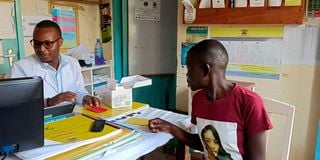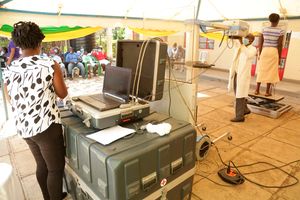The rebirth of tuberculosis

Ms Linda Awuor collects TB drugs at Homa Bay County Teaching and Referral Hospital on June 21,2022
What you need to know:
- Kenya has remained on the list of the top 22 countries with the highest prevalence of TB.
- TB remains the fifth leading cause of death in Kenya. With the HIV pandemic in the late 90s and the early 2000s, we had a sudden upsurge of TB that grossly negated the gains that had been made in taming the disease in the 80s.
The young boy sits on his bed in the critical care unit, looking forlorn. The sun streaming into the room makes for a promise of absolute bliss outdoors, but he does not have the freedom to bask in it. He is hooked onto an oxygen mask that would not allow him to move around. Today, he can only look through the window and longingly wait for the day he will be free of the life-giving tubes. In the entire six-bed unit, he is alone. The other machines are silent, the beds stripped and the lockers bare. It is a lonesome existence.
I don’t get his name but he looks like ‘Donny’ would suit him. He is having a chest physiotherapy session and these sessions are not for the faint-hearted. The physiotherapist’s eyes, peeping over her mask, are warm and kind, not matching up to the rigorous steps she is putting Donny through, to ease his breathing and aid in the removal of chest secretions.
Donny has been in the unit for over two weeks now, having been referred to the hospital from a smaller peripheral centre, with difficulty in breathing. He had been diagnosed with drug-resistant tuberculosis (TB), with symptoms worsening despite being on treatment. The immediate reason for referral was to ensure he got respiratory support in the critical care unit, even as his treatment is being adjusted to combat the deadly disease.
Due to the extremely high-risk nature of his condition, Donny’s presence in the unit automatically turns it into a quarantine unit. No one else can share the room for fear of contracting this difficult-to-treat form of tuberculosis. The doctors and nurses attending to Donny have to wear protective gear and take measures to ensure that they do not get infected in the line of duty.
In a different facility 80 kilometres away, little Lily* is another TB patient, an enigma at that. At only three months old, she is swaddled, lying on the bed, tucked into her mum’s chest. Lily’s mum is a TB patient who was diagnosed recently. Despite concerted efforts to initiate treatment and monitoring to ensure compliance, Lily’s mum remained a hard nut to crack. Compliance to her own treatment was an issue, let alone ensuring that Lily got the necessary prophylactic medication to protect her from getting the infection from her mum.
It took a while to catch up with Lily’s preventive care and by this time, Lily was already in trouble. My good old Prof Samuel Ayaya would never let us forget the TB mantra: TB can affect any organ or tissue in the body, except your hair, teeth and nails. Everything else is fair game. I have seen TB in all its versions: pulmonary TB in the lungs; and extrapulmonary TB affecting other organs, including TB meningitis, brain tuberculomas, TB of the spine, abdominal TB, TB of the genital tract, you name it. I had never seen TB of the spleen!
Listening to the paediatrician describe little Lily’s condition, I was devastated. Having TB at three months is in itself almost unheard of. All babies born to mothers with TB or living in a household with a person with TB are immediately put on TB prophylaxis medication, to protect them. Not only did we miss the bus in protecting Lily, but she ended up with one of the most uncommon presentations, TB of the spleen!
Kenya has remained on the list of the top 22 countries with the highest prevalence of TB. TB remains the fifth leading cause of death in Kenya. With the HIV pandemic in the late 90s and the early 2000s, we had a sudden upsurge of TB that grossly negated the gains that had been made in taming the disease in the 80s. HIV causes immunosuppression, increasing vulnerability to TB.
Many of our HIV patients inadvertently succumbed to TB. With the large numbers of patients with TB, it was not unexpected to see a slow but steady increase in the number of patients with drug-resistant tuberculosis. With approximately 86,500 patients diagnosed with TB in 2019, to have 688 of them have drug-resistant TB is worrisome. What is causing even more apprehension is the anecdotal evidence of a rise in the overall number of TB patients and the disproportionate rise in the numbers of those with drug-resistant TB across the country in this past year.
Part of this rise is thought to be attributed to the Covid-19 pandemic that disrupted health systems across the country. TB treatment can last anything from six to 24 months, depending on treatment response, the affected body tissue and whether drug resistance is a contributing factor. Patients with TB require very close follow-up and consistent reviews to confirm treatment response at all stages of treatment. Any small disruption to this process leads to the possibility of treatment failure.
Commitment to treatment is a team effort, from the patient, the family, the care providers and the financiers of the TB programmes. This greatly contributes to reducing morbidity and mortality, spread of disease to close contacts, treatment failure and drug resistance.
As a country, we are greatly privileged to have treatment regimens for drug-resistant TB that can be taken orally. Gone are the days of the painful daily injections for months for these patients. This has done well to improve treatment compliance but at a price! It costs an arm and a leg to treat drug-resistant TB as the second line treatment regimens are not cheap.
There is an urgent need to raise awareness about this trend. The special populations at high risk of contracting TB have traditionally been those with HIV disease, prisoners, refugees, health workers and persons of low socio-economic status living in crowded informal settlements. This has made those in middle and high-income backgrounds, to remain complacent, and less likely to be screened for TB until it is too late.
You are a potential TB patient, never forget that!
Dr Bosire is an obstetrician/gynaecologist





